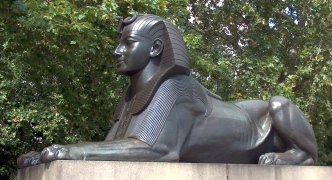
The Sphinx, with a human head and a lion's body, has been a fairly popular subject for mythological sculpture in England, with periodic enthusiasm according to various discoveries of antiquities in Egypt. In looking at a few examples, we begin with the pair of sphinxes flanking Cleopatra's Needle on the Victoria Embankment, designed by Vulliamy, the architect, and modelled by the sculptor C. H. Mabey. A picture of one of the pair is at the top of this page - it needs clicking on to see properly. Of very large size, this sphinx shows the characteristic attributes of a male sphinx. The lion's body is seated, forearms placed forward in front of the body, symmetrically - indeed, the whole pose is symmetrical. The fairly vertical chest rises to a thick neck, bearing the head of an Egyptian Pharaoh with headdress. He gazes straight ahead, enigmatically - the expression is unusual here in that there is a faint smile to the mouth. The tail, not seen in this view, is coiled up forwards on one side, catlike.
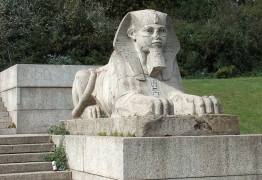
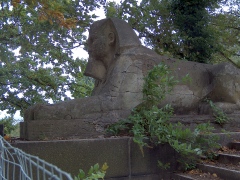 Crystal Palace Sphinxes, 1851.
Crystal Palace Sphinxes, 1851.
The other example of extremely large sphinx sculpture in London is in the park at Crystal Palace, where there are a group of stone ones, of which two are shown above. The better preserved example is on the left, but in terms of evocativeness, the one on the right lurking in the gloom of the forest as if some part of an ancient, undiscovered city is the better. Again with a Pharaoh's head, but smaller relative to the body, and with particularly massive front paws. The curved up tail can be seen in the example to the left. As with the Cleopatra's needle sphinxes, they are decorated with hieroglyphs.
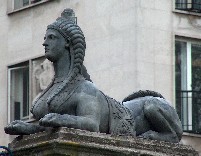
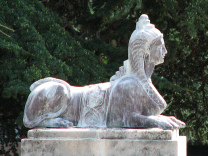 Green Park sphinx, probably by Henry Cheere, and Chiswick sphinx.
Green Park sphinx, probably by Henry Cheere, and Chiswick sphinx.
The archetypical female sphinx in British sculpture is found on the north side of Green Park, on the gates bordering Piccadilly. This pair of small lead sphinxes, of which one is shown above, may be fairly confidently attributed to the sculptor Henry Cheere (see the brief discussion on the Piccadilly page. The female head is classical, but wears her hair in two carefully plaited strands at least evocative of an Egyptian headdress; these plaits fall symmetrically over her breasts. The neck is long and columnar, the lion's body a little small for the size of head. This can be explained by the sculptor's dilemma in joining animal and human parts; if we think of a lion, especially a male one with its mane, then the size of head is relatively large. But if we think of a woman, then the size of the body should be larger in proportion to the head. As with the male sphinx, the tail is looped up on one side and over one haunch. Almost identical sphinxes are in Chiswick House Park, above right.
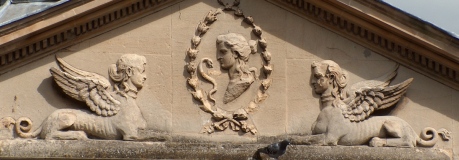 Winged sphinxes in high relief, tails backwards.
Winged sphinxes in high relief, tails backwards.
The pair of sphinxes in a pediment above, high relief in stone, are unusual in that the tails go backwards, with elegant loops. Otherwise, they have the conventional pose, reclining and with long, columnar neck. In this case, the hair is wavy rather than like a headdress, and the faces are more 19th Century than classical. And they are winged - a common variation of the female sphinx. The coiled tails and pose are familiar. The central plinth bears a relief of a sphinx facing towards the viewer, which looks oddly proportioned - unlike the inward facing pair, where the sculptor has found a rather satisfying proportionality between head and body.
Sphinx statues do tend to go in symmetrical pairs. Here is a niche with a pair of male sphinxes, nicely modelled by the firm of Daymond and Son.
Egyptian sculpture is associated with the culture of death, of course, and so Egyptian motifs were popular in graveyards during the 19th Century. Here, above left, is a typical example of a graveyard sphinx. Rather androgynous in this case, with particularly powerful front limbs, as in the Cleopatra's Needle examples above. And above right is a marble sphinx which is of a rather similar type, though the head is proportionately larger to the body.
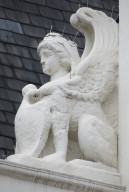
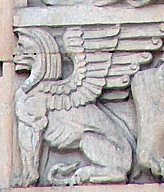 Sphinx sculptures with upright seated posture.
Sphinx sculptures with upright seated posture.
There is of course another way in which cats can sit, which is upright, with front legs vertically down. If the posture shown so far is termed 'couchant' heraldically, then this upright posture is the 'sejant' pose. The example above left, rather light-hearted, shows the type, with a tall rather than low profile. In this case, she is very heraldic, with a shield, and she is winged, with the wings curved up and above her head. The sphinx sejant in relief above right, also winged, is a rather strange one - the face seems to be a skull, and the tail is unusually foward under the chest rather than looped up. It is actually supporting a chair - click on it to see the full composition. L. F. Roselieb, an accomplished sculptor in Edwardian times, was the artist.
We end with variations on the theme. Above left, a curious standing example, with Cretan headdress, tail bacwards and coiled upwards to meet the wing. It is in low relief for a large medallion. Central, what can only be described as a two-headed dachshund version of a sphinx, most curious. And we end with the example below right, of a winged sphinx for a park bench.
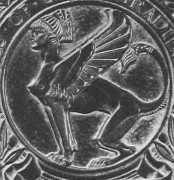
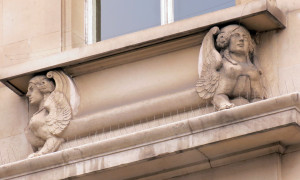
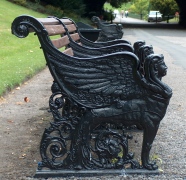 Variations of sphinx sculpture.
Variations of sphinx sculpture.
Visits to this page from 13 Mar 2014: 14,322
Mermaid sculpture // Dragon sculpture // Allegorical sculpture
Animal sculpture // Lion sculpture // Camel sculpture